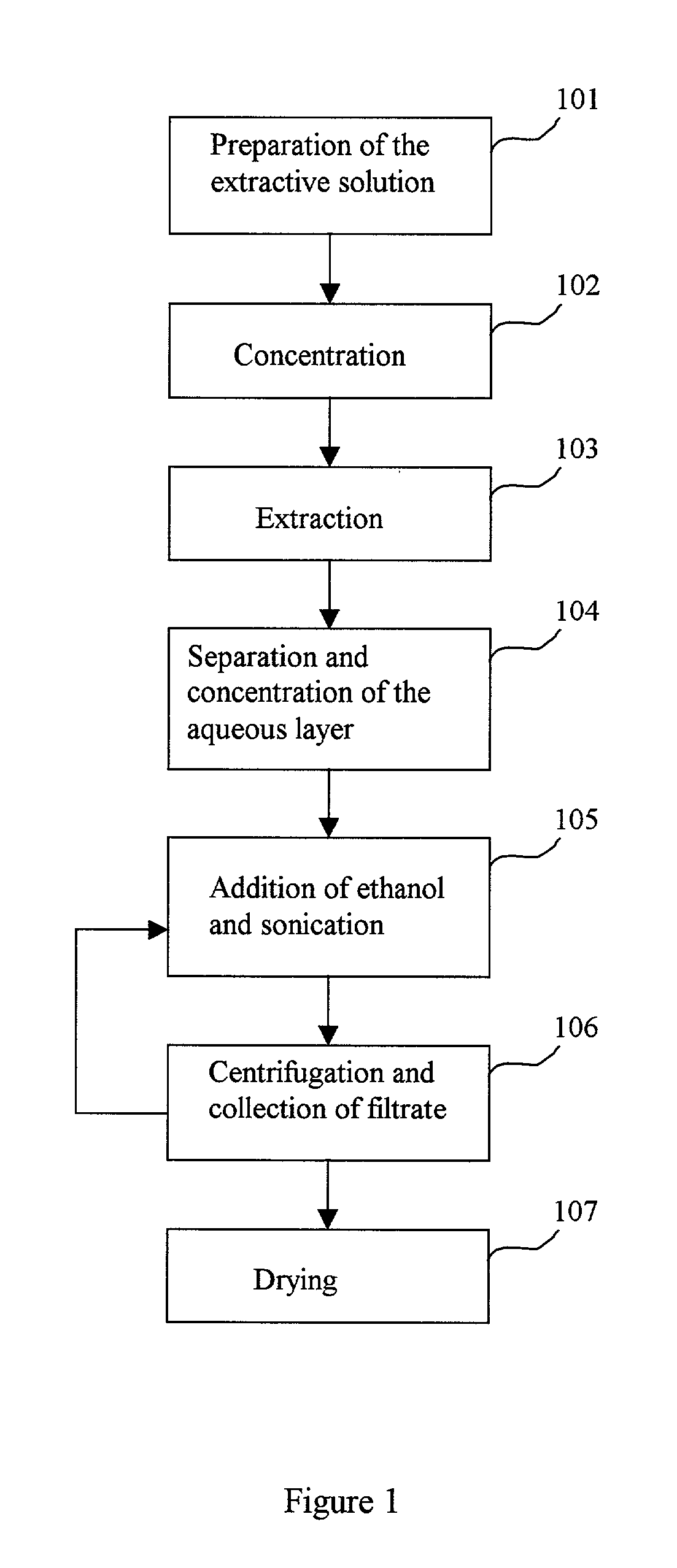Process for extracting glycoside using an aqueous two-phase system
- Summary
- Abstract
- Description
- Claims
- Application Information
AI Technical Summary
Problems solved by technology
Method used
Image
Examples
example 2
[0042] Extracting glycosides from rhubarb using an aqueous two-phase system.
[0043] 1. 10 g of rhubarb was mildly ground and mixed with 300 g of water. the mixture was agitated (200 rpm) at room temperature for 30 minutes. After filtration, the filtrate was collected as the aqueous extractive solution. This extractive solution contained 3.71% of sennosides as determined by HPLC.
[0044] 2. 115 ml of the extractive solution is concentrated to 20 ml. The solid content of the extractive solution concentrate is approximately 6.43%.
[0045] 3. 1 g (5%) of sodium biphosphate (Na.sub.2HPO.sub.4), 2 g (10%) of PE62 and 4 ml (20%) of ethanol are added to the extractive solution concentrate and then mixed thoroughly. The phase separation is performed by keeping the solution in a water bath at a temperature of 70.degree. C. for 1-1.5 hour.
[0046] 4. The upper layer (aqueous) is separated from the lower layer (PE62) using centrifugation (3000 rpm). Then, the water layer is carefully removed and conce...
example 3
[0051] Extracting glycosides from root of herbaceous peony using an aqueous two-phase system.
[0052] 1. 10 g of root of herbaceous peony was mildly ground, mixed with 200 g of water, and boiled for 60 minutes. After filtration, the filtrate was collected and the remaining root of herbaceous peony was again mixed with water, boiled, and filtered. The aqueous extractive solution was obtained by combining the filtrates. This extractive solution contained 1.36% of paeoniflorin as determined by HPLC.
[0053] 2. 158 g of the extractive solution is concentrated to 40.65 g. The solid content of the extractive solution concentrate is approximately 4.52%.
[0054] 3. 3.2 g (8%) of sodium dihydrogen phosphate (NaH.sub.2PO.sub.4), 4.8 g (12%) of PE62 and 4 ml (10%) of ethanol are added to the extractive solution concentrate and then mixed thoroughly. The phase separation is performed by keeping the solution in water bath at a temperature of 70.degree. C. for 1-1.5 hour.
[0055] 4. The upper layer (aque...
PUM
| Property | Measurement | Unit |
|---|---|---|
| Fraction | aaaaa | aaaaa |
| Fraction | aaaaa | aaaaa |
| Angle | aaaaa | aaaaa |
Abstract
Description
Claims
Application Information
 Login to View More
Login to View More - R&D
- Intellectual Property
- Life Sciences
- Materials
- Tech Scout
- Unparalleled Data Quality
- Higher Quality Content
- 60% Fewer Hallucinations
Browse by: Latest US Patents, China's latest patents, Technical Efficacy Thesaurus, Application Domain, Technology Topic, Popular Technical Reports.
© 2025 PatSnap. All rights reserved.Legal|Privacy policy|Modern Slavery Act Transparency Statement|Sitemap|About US| Contact US: help@patsnap.com

